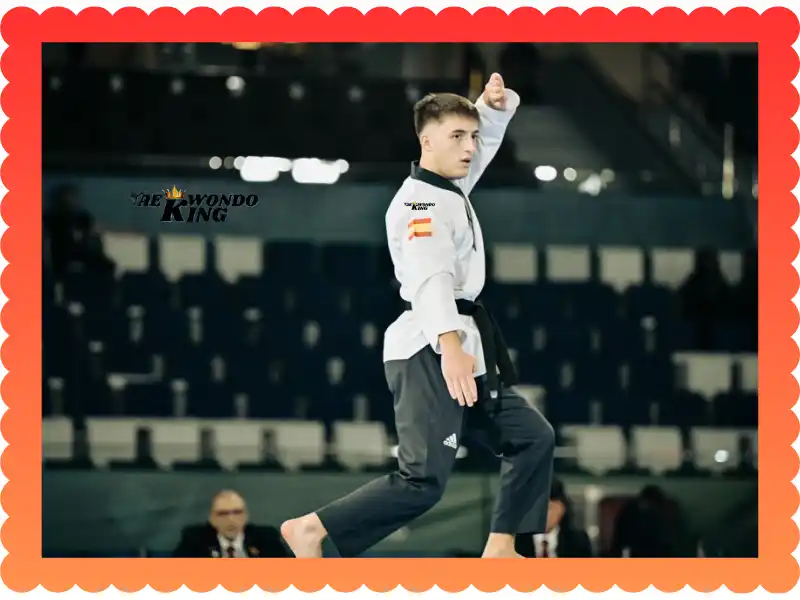
If you are looking to become a master Taekwondo forms, it is important to have a strong understanding and regular practice of the fundamental techniques and principles of this martial art. Whether you are just starting or have some experience in Taekwondo, mastering the forms can greatly enhance your skills. Let’s take a closer look at the essential steps to mastering Taekwondo forms and becoming a more skilled practitioner.
As a 3rd Dan black belt and experienced Taekwondo instructor, I understand the profound significance of forms or poomsae. These intricate sequences of movements are not just a display of physical prowess; they are a gateway to deeper understanding, discipline, and martial arts mastery.
What are Taekwondo Forms?
Taekwondo forms, also known as poomsae (pumsae, poomse, etc.), are a fundamental element of Taekwondo practice. They are essentially predetermined sequences of movements that simulate fighting against imaginary opponents.
Here’s a breakdown of what they are and their significance:
Key Features:
- Standardized Movements: Each form consists of a specific order of blocks, strikes, kicks, stances, and breathing techniques.
- Practice without Partner: Forms allow you to practice and refine your technique without needing a sparring partner.
- Belt Testing Requirement: Performing forms correctly is often a requirement for progressing through belt ranks.
Benefits of Forms:
- Technique Development: Forms help refine basic techniques, improve precision and power in strikes and kicks, and develop proper breathing control.
- Physical Conditioning: Performing forms regularly enhances cardiovascular endurance, flexibility, and overall physical fitness.
- Mental Focus: Forms require concentration and discipline, improving focus and mental control.
- Self-Defense Application: While not direct combat training, forms lay the foundation for practical self-defense techniques.
Types of Taekwondo Forms:
- Variations: Different Taekwondo federations and schools might have slight variations in their forms.
- Common Systems:
- WTF (World Taekwondo Federation) Forms: Often referred to as Taegeuk forms, these are standardized forms used in Olympic Taekwondo.
- ITF (International Taekwondo Federation) Forms: These forms, called Tul, are another common system.
- Traditional Styles: Some traditional Taekwondo schools might have their own unique sets of forms.
Learning and Progressing:
- Beginner Forms: Early forms are typically shorter and focus on fundamental movements.
- Advanced Forms: As you progress, forms become more complex, incorporating more intricate techniques and combinations.
- Practice and Repetition: Mastering forms requires consistent practice and attention to detail.
Remember: Forms are a vital part of Taekwondo training, offering a multitude of benefits for both physical and mental development.
World Taekwondo forms/Taekwondo Poomsae 1-17 name
Kukkiwon and World Taekwondo (WT) styles have a set of standardized forms with specific names. Here is an example list based on the Kukkiwon/WTF-style Taekwondo:
- Taegeuk Il Jang
- Taegeuk Ee Jang
- Taegeuk Sam Jang
- Taegeuk Sa Jang
- Taegeuk Oh Jang
- Taegeuk Yook Jang
- Taegeuk Chil Jang
- Taegeuk Pal Jang
- Koryo
- Keumgang
- Taebaek
- Pyongwon
- Sipjin
- Jitae
- Cheonkwon
- Hansu
- Ilyo
How do I get better at Taekwondo?
Here are some key ways to improve your Taekwondo skills:
Training:
- Consistent Practice: Attend classes regularly and supplement them with additional practice at home.
- Focus on Fundamentals: Master the basics of stances, kicks, punches, blocks, and breathing techniques.
- Variety in Training: Incorporate different drills, shadowboxing, and partner work to enhance your skills.
- Strength and Conditioning: Work on building strength, flexibility, and cardiovascular endurance through additional exercises.
Learning and Improvement:
- Seek Feedback: Ask your instructor for feedback on your technique and areas for improvement.
- Watch and Analyze: Observe experienced practitioners and analyze their movements to learn and refine your own.
- Visualize: Mentally rehearse techniques and imagine successful execution to improve muscle memory.
- Challenge Yourself: Gradually increase the difficulty of your training as you progress.
Additional Tips:
- Discipline and Focus: Maintain focus and discipline during training to maximize your learning.
- Enjoy the Process: Have fun with your training and celebrate your progress along the way.
- Stay Motivated: Set realistic goals and track your progress to stay motivated.
Remember, improvement in Taekwondo takes dedication, consistent effort, and a willingness to learn from your instructors and peers.
How to get better at Taekwondo Poomsae?
Here are some key ways to improve your Taekwondo poomsae skills:
Focus on Fundamentals:
- Stances: Master the proper execution of each stance, ensuring balance, alignment, and power.
- Techniques: Sharpen your basic kicks, punches, and blocks, focusing on precision, speed, and control.
- Breathing: Develop proper breathing techniques to maintain stamina and power throughout the form.
Practice Techniques:
- Isolation: Practice individual techniques outside the form to refine them before integrating them into the flow.
- Slow Motion: Practice the form slowly, focusing on each movement’s details and proper execution.
- Mirror Work: Practice in front of a mirror to observe your form and identify areas for improvement.
Refine the Form:
- Transitions: Ensure smooth transitions between movements, maintaining rhythm and flow.
- Power and Snap: Execute techniques with power and snap, emphasizing the “explosive” moments.
- Focus and Control: Maintain focus and control throughout the form, avoiding unnecessary movements.
Additional Tips:
- Memorization: Thoroughly memorize the sequence of movements for accurate execution.
- Visualization: Visualize yourself performing the form flawlessly to improve muscle memory.
- Record Yourself: Videotape yourself and analyze your performance to identify areas needing improvement.
- Seek Feedback: Ask your instructor for guidance and feedback on your poomsae execution.
- Competition: Participating in poomsae competitions can provide motivation and valuable feedback.
How to become a master in Taekwondo?
Becoming a master of Taekwondo Forms requires a dedicated and long-term commitment that goes beyond simply achieving a black belt. Here are some key steps on the path to mastery:
Technical Expertise:
- Mastery of Fundamentals: Thorough understanding and flawless execution of basic techniques like stances, kicks, punches, blocks, and breathing.
- Advanced Techniques: Proficiency in complex techniques like high kicks, spinning kicks, and various combinations.
- Poomsae Perfection: Exceptional execution of Taekwondo forms, showcasing precision, power, and control.
Beyond Technique:
- Physical Conditioning: Peak physical fitness with emphasis on strength, flexibility, cardiovascular endurance, and agility.
- Mental Discipline: Develop unwavering focus, mental control, and the ability to perform under pressure.
- Continuous Learning: Maintain a thirst for knowledge, actively seeking new ways to improve and evolve your skills.
Additional Factors:
- Competition Experience: Participating in competitions can test your skills against others and provide valuable feedback for improvement.
- Teaching and Mentoring: Sharing your knowledge and guiding others on their Taekwondo journey deepens your understanding and leadership skills.
- Dedication and Perseverance: The journey to mastery takes years of consistent training, overcoming challenges, and pushing your limits.
Remember:
- Time Commitment: Reaching mastery takes significant time, often exceeding a decade of dedicated training.
- Formal Recognition: The title of “master” might be formally awarded at specific black belt levels within different Taekwondo organizations.
- Lifelong Journey: Mastery is not a destination but a continuous process of refinement and self-improvement.
By focusing on technical excellence, physical conditioning, mental discipline, and a lifelong commitment to learning, you can embark on the path toward becoming a master in Taekwondo.
FAQs
What are Taekwondo forms (poomsae) and why are they important?
Forms are structured sequences of movements that represent fundamental techniques and fighting applications. They are crucial for refining techniques, building focus, and gaining a deeper understanding of Taekwondo.
How can I start mastering Taekwondo forms?
- Find a good instructor: A qualified instructor can break down the movements, explain their meaning, and provide personalized feedback.
- Start with the basics: Begin with simpler forms and focus on proper technique before progressing.
- Practice regularly: Repetition is key. Dedicate time daily or several times a week to practice your forms.
Does mastering forms make me a better fighter?
A: While forms don’t directly translate to sparring, they refine your technique, build muscle memory, and improve coordination, all of which contribute to better overall fighting ability.
What are some tips for improving my form execution?
- Visualize: Imagine the applications of each technique and connect them with the form’s deeper meaning.
- Seek feedback: Actively ask your instructor and senior students for guidance on areas for improvement.
- Practice slow and controlled movements: This helps refine technique and build muscle memory.
How long does it take to master a Taekwondo form?
Mastering a form is a continuous process. While basic forms can be learned in weeks with consistent practice, true mastery takes dedication and years of refinement.
Are there any benefits to practicing forms beyond physical technique?
Absolutely! Forms cultivate mental focus, discipline, coordination, and a deeper appreciation for the history and philosophy of Taekwondo.
What are some common mistakes people make when practicing forms?
Rushing through the movements, focusing solely on memorization without understanding the techniques, and neglecting proper breathing and focus are common pitfalls.
How many Taekwondo forms are there in the world?
The number of Master Taekwondo Forms worldwide can vary due to different organizations and styles. Generally, there are numerous forms, each with its own set of movements and techniques. The ITF recognizes 24 patterns, while the WTF has 17 recognized patterns. Additionally, various other styles and schools may have their unique forms.
How many patterns are in Taekwondo?
In Taekwondo, various patterns are depending on the specific style or organization. For example, the ITF (International Taekwon-Do Federation) has 24 patterns, while the WTF (World Taekwondo Federation) has 17 recognized patterns. Each pattern represents a set sequence of movements designed to develop specific techniques and skills.

Founder, Owner, and CEO of TaekwondoKing.
He is one of the top 100 martial artists in the World and among the top 20 referees in Bangladesh.
Ehatasamul Alom is an esteemed Kukkiwon Certified Taekwondo 3rd Dan Black Belt with over 15 years of experience in this dynamic martial art. Born in Rajshahi, Bangladesh, Ehatasamul’s journey with Taekwondo began at the tender age of seven. His passion led him to compete at national and international levels, where he has bagged numerous awards and honors. He is also a member of the Taekwondo National Referee Panel.
With a Bachelor’s degree in Sports Science from the prestigious Rajshahi University, Ehatasamul has a deep understanding of the technical and scientific aspects of martial arts and some other martial arts.
In 2022, Ehatasamul created the “TaekwondoKing.com” blog to share his knowledge and Real experiences. His articles focus on Taekwondo training techniques, competition strategies, and the art’s rich history and philosophy. He also writes about the importance of mental fortitude and discipline, key aspects of his teaching philosophy. His goal is to inspire both beginners and seasoned practitioners worldwide through insightful and engaging content.
If you need any help, contact Ehatasamul Alom at any time.




